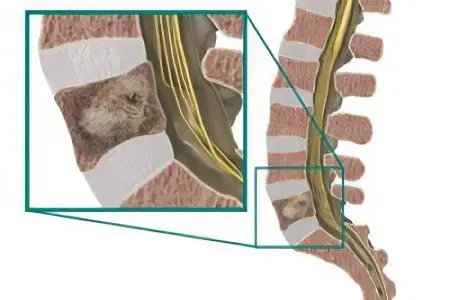Contents

Among the many diseases of the spinal column, oncological neoplasms are much less common than oncopathologies of other organs and the skeleton. However, the nature of the disease is such that the tumor is very difficult to detect even during a clinical examination. This is due not only to unclear symptoms, but also to difficulties in pathomorphological, clinical and instrumental diagnostics.
The manifestations of symptoms are so diverse that it is not possible to determine with accuracy the diseased organ. Here there are frequent errors in the correctness of the diagnosis, and, as a result, incorrectly chosen treatment tactics.
One of the varieties of oncopathologies of the spine is sarcoma, which develops from the tissue of the spine itself. This is the most aggressive type of tumor, which has a short period of development – from 1 month to 1 year.
Symptoms of the disease
constant pain in the spinal column;
limited functions of the spine;
the forced need to take a special position in which the pain is somewhat dulled;
neurological disorders;
drastic weight loss;
constant fatigue and general severe condition of the patient.
As a rule, with oncopathology of the spine, there is always a disorder in the function of the sphincter of the rectum and urinary canal. As a result, a cancer patient has involuntary defecation and urination.
Classification and varieties of oncopathology
In practical medicine, several types of this kind of tumors are distinguished, differing from each other depending on their nature of occurrence:
localization in the bones – osteosarcoma;
localization in muscle tissue – fibrosarcoma;
oncological formation – chondrosarcoma, cartilaginous origin;
metastatic spinal tumor.
Tumor cells strongly affect the nerve roots of the spine and the spinal cord itself, which has a very negative effect on the patient’s condition. It is characteristic that if the sarcoma has developed directly in the spinal cord, then the disease rapidly manifests itself in the conjugated parts of the body.
Those types of tumors that have formed outside the spinal cord usually develop for a long period of time, up to a year, before affecting the nerve endings.
If cancer formation has a metastatic character, then, as a rule, it is a consequence of the main oncological disease of another organ, and develops very quickly.
Ewing’s sarcoma mainly affects the tubular leg bones and is most common in young adults.
Based on the location and level of tumor damage, there are:
cervical location;
thoracic localization;
transverse spine;
lower portion of the spinal cord.
According to symptomatic signs, tumors of a segmental nature are isolated, manifested by a violation of the musculoskeletal system, the vascular system, and involuntary movements. Typical manifestations characteristic of localized tumors in the spinal cord are the first “bell” as a result of their appearance.
Initially, radicular nerve endings in the region of the spinal tissue are damaged in rapidly developing oncopathology. Reveal themselves in the form of neuralgic pain, various etiologies of radiculitis. They are characterized by pulling, shooting or all-encompassing pain manifestations. Sometimes radicular disorders take on the character of symptoms of herpes zoster. Because of this disguise, timely diagnosis of the disease is difficult.
Dysfunction of the motor apparatus is manifested in conduction pathologies. Here, areas of the body below the location of the sarcoma are affected, and paresis and paralysis may appear as a result of damage to the central nervous system. In this case, the spinal cord is compressed, causing an increase in the turgor of the muscular-ligamentous tissue, protective reflexes are pathologically expressed, reducing the tendons.
Diagnosis and treatment of the disease

To start timely treatment, it is necessary not to ignore the first characteristic symptoms of this formidable disease, but to immediately consult a doctor. Clinical examinations, including magnetic resonance and computed tomography, ultrasound examination, biopsy for histological examination of the properties of the tumor, provide a comprehensive and complete diagnosis.
Then a medical consultation is assembled, including oncologists, radiologists and surgeons, to determine the treatment algorithm.
The therapeutic tactics of such oncopathology involves mandatory surgical excision of the tumor, radiation and chemotherapy. Now oncosurgeons are trying to perform the operation to remove the sarcoma as accurately as possible in order to preserve the vascular and nerve plexuses in the affected areas in order to preserve the motor and nervous functions of the body.
If it is necessary to remove a limb, then doctors immediately offer to perform an operation to install a prosthetic device, and if you have to operate on the knee joint, then preserving it as much as possible is now a common practice.
Only timely treatment allows you to maintain a high quality of life for the patient.
Causes of the disease
Scientists studying the problems of oncology put forward many versions of the causes of such a formidable disease as spinal sarcoma. However, no single exact cause has yet been identified. Probably, there may be various factors influencing the onset of the development of the disease.
This may be a genetic predisposition to the disease, laid down even in the embryonic period, and poor ecology, and malnutrition, and work in harmful conditions with increased radiation or gas pollution, and injuries that give a sharp impetus to the development of oncopathology.
Therefore, in order to minimize the creation of favorable conditions for the development of the disease, it is necessary to lead a healthy lifestyle, providing a balanced diet, feasible physical exercise and, if possible, not exposing yourself to unreasonable risks.









